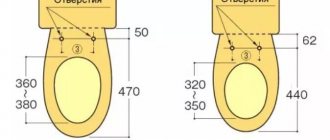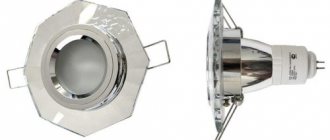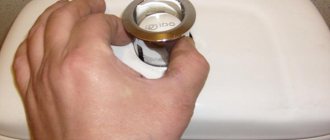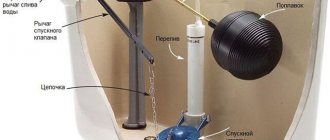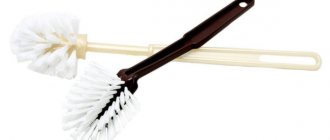Repair it yourself or call a plumber?
Repairing a Rock toilet with your own hands is not difficult if you are familiar with the structure and operating principle of the fittings, fixing the tank, and connecting plumbing. If you lack the skills, it is better to contact the service - it is convenient, reliable, and will eliminate incorrect installation of mechanisms and leaks.
Leave a request for a technician to visit you within the Moscow Ring Road for free
Aquasliv specialists arrive at the agreed time, coordinate the work, install original fittings, and provide a guarantee for spare parts and repairs.
To other materials:
- How to choose a toilet seat
- IDO toilet repair
Why do you have to remove the cover?
The parts inside the toilet cistern can be divided into two components: the water drainage mechanism and the water intake mechanism. Water is drawn to a certain level, after which the shut-off device (valve) is activated. When we press a button or pull up the release lever, another locking device (elastic band, bulb) rises and water is poured into the toilet.
Everything is simple in principle. These mechanisms are adjustable depending on the dimensions of the tank. They are usually made of plastic, some rubber parts, and can deteriorate over time. Therefore, if you notice problems, you need to go inside and either adjust the devices or change them. If you decide to look inside the tank, then you have one of these problems:
Water constantly pours into the toilet.
There is no water drainage.
Insufficient amount of water when draining.
Water runs from under the tank.
Other types
I would like to say a few words about tanks with two buttons, you need to understand that they are not the same! There is a cheap fitting inside, but at the exit it has two buttons - it can also be removed, just look at the instructions above.
However, there are designs that have actually saving fittings in their structure; they are configured and work completely differently, and their removal can also differ significantly from an “ordinary” tank.
But the most difficult thing is to disassemble the built-in type; usually they are embedded in the wall and each time dismantling it means dismantling part of the wall. This is a very expensive service that you are unlikely to do yourself. So you need to think ten times before buying such toilets, if only to save space in the bathroom or toilet.
In conclusion, I would like to tell you, if you climb into the toilet to adjust, remember - you must know what you are doing, otherwise you simply risk flooding your neighbors. If you have never adjusted the “fittings” yourself, it’s better to call a plumber, let him take the money, but do everything as efficiently and quickly as possible.
I’m finishing my article, I think you found it useful, read our construction site.
Source
How to open a toilet cistern
Malfunctions of the toilet cistern
A toilet is an essential item for every home. When it breaks, the whole family suffers. If you can't call a plumber, you can try to fix it yourself.
Diagram of the drain tank.
But to understand the cause of the malfunction, you need to figure out how to open the toilet cistern. After all, most often breakdowns occur in it, since this is the most problematic part of the device.
Diagram of the drain tank.
Main causes of malfunctions:
- No water flow.
- Continuous filling.
- Leakage.
- Continuous flushing of water into the toilet.
Absolutely any toilet tank is a container of water covered with a lid that can be opened. There are side or top positions of the water drainage mechanism. The side arrangement, when the tank is located high at the top, and the water drains after you pull the chain, is now extremely rare. The bulk of modern toilets have a top flush device. This can either be a handle that you pull up, or a button that you press.
Modern toilets with a button
Diagram of a toilet with a button.
On toilets where water is drained by lifting the rod upward, first unscrew the ball located at the end of this rod, then remove the lid by simply lifting it up. But how to open the tank of a modern device if the lid does not lift at all? By the way, for some reason many plumbers try to convince you that a toilet with a button cannot be opened, because it is a non-demountable structure. This is wrong. Modern toilet models equipped with one or two flush buttons have a push-button glass that prevents the lid from lifting. To open such a tank, you need to press your fingers on the chrome ring that is located around the button and turn it counterclockwise. If you haven't opened the lid for many years, the threads may become stuck. Try to turn it in one direction or the other. You can drop a little machine oil and then try to turn the rim again.
If the headband slips under your fingers, use a screwdriver or other flat tool
Carefully pressing the ring with a screwdriver, you should try to move it slightly counterclockwise. After shifting it at least a couple of millimeters, it will begin to rotate much more freely, and you can easily unscrew it with your fingers
Unscrewing it will release the plastic cylinder. After this, lift the lid and turn it across the tank body 90 degrees. The button block is held in place with a double-sided clothespin. Depending on the toilet model, the clothespin is either unfastened or unscrewed. After this, you can completely remove the lid and open the tank.
If the toilet is equipped with a double button, then it does not unscrew, but is simply removed. First you need to sink one of the halves, then a small groove will become visible on the side. You should carefully pry it out with a screwdriver and pull out first one and then the other halves up. When both parts of the button are removed, the head of the screw will become visible, unscrewing which you can open the tank. In some models with a double button, you need to press first on one half, then on the other, and then, grabbing the jumper, unscrew it.
When carrying out plumbing work, do not forget about safety precautions. First, turn off the water supply valve and empty the tank
Lay out all elements that will be removed from the toilet on a flat surface. Make sure that small parts are not swallowed by pets. Place the removed cover somewhere to the side. Because if you accidentally bump it or drop something heavy on it and it breaks, you won't be able to buy it separately. Then you will have to change the entire tank.
Removal instructions
To begin with, I will say that I will show everything on my toilet, mine is SANTEK, but it has a similar design to many “budget” manufacturers, such as SANITA, Jika, Roca, Cersanit, etc. so it will be useful for you too. I would also like to note that I have one button, that is, not an economical option; there are more advanced models. SO:
- We see the button on top, it sits firmly.
- In order to remove the cover, we need to unscrew the socket of this button itself.
- To do this, we begin to rotate it counterclockwise! Often the ring begins to rotate easily, but sometimes it is made of metal, and there are “risks” on it, into which you need to insert something metal and “lightly” hit it, I note again - EASILY, otherwise you can simply split the lid (usually a screwdriver is used ). After this, such a metal ring will also begin to rotate.
- Next, simply unscrew this fastener until the end.
- It will come out with the button.
The process of dismantling a product with one button on the lid
Before removing the lid from the toilet, you need to firmly grasp the ring surrounding the button and turn it. If the element is clamped tightly, you can use pliers, but do not forget to wrap the ring with a rag or just paper. This will help prevent scratches on it. As soon as you feel that the fastening has given way, continue the actions only manually.
You need to turn the part counterclockwise, otherwise you will tighten the fastener even more and risk completely stripping the threads from the base cylinder. The ring should be unscrewed very carefully so as not to damage the surface of the tank. After removing the part, which has a cylindrical shape, you can proceed directly to removing the cover.
You need to be very careful when unscrewing the ring that secures the button.
The design is attached to the button itself on a special clip with latches on both sides. First you need to slightly lift and rotate the lid perpendicular to the tank. This will help you access the clothespin. Carry out all actions smoothly and slowly, so as not to accidentally damage the fastening points inside the tank.
Next, having unfolded the part, you can grab the right latch with one hand and the left one with the other. Rotating the clothespin around its own axis, turn the knots in directions opposite to each other. A characteristic click will indicate that the fastener has been released and you can easily remove the cover.
Some general rules.
These rules apply to the assembly and disassembly of any mechanism; they should also be observed when disassembling the toilet cistern.
1) When you disassemble any device (part, assembly, mechanism), remember the order of your actions so that there are no problems during reassembly.
2) Do everything carefully: fold fragile parts so that they do not break (this also applies to the ceramic tank lid), put all fasteners in one place and so that they do not fall under your feet during work.
3) If something does not unscrew (does not come off, does not turn), then most likely you are doing something wrong. When disassembling a mechanism that is unfamiliar to you, apply your efforts gradually. Grandfather's method of hitting it harder with a hammer to make it work won't work.
So, let's start from the simplest. How to remove the toilet tank lid without a button. All old-style toilets and some new models have such a device. The lid is not fixed to the tank in any way and in order to remove it, you just need to unscrew the cap on the release lever.
What is double flush
To wash away waste and clean the bowl itself, a flow of water of a certain power and duration is required. Consumption rates for plumbing fixtures have long been determined and calculated. However, in many cases such power and size of the jet are simply not needed. But the regular model does not involve any adjustment.
The dual flush model allows you to reduce water consumption and ultimately pay less for using your water supply.
We are talking about a special mechanism that creates 2 drain modes:
- economical - only half the standard volume is supplied;
- normal – full volume of water.
The flow power in both cases is the same, but the different values allow for savings. The most famous representatives of this category include products from Roca and Jika. The adjustment is made by pressing the double button located on the drain tank: the part labeled ½ - economy mode, or the larger one - normal.
A variety of models with this mechanism are produced: floor-standing, for example, Roca Victoria, compact JikaLyra, hanging Gustavsberg.
